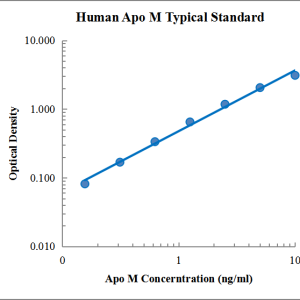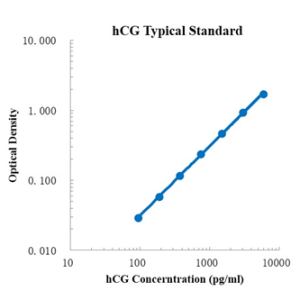Human Angiopoietin-2/ANG-2 ELISA Kit
$299.00 – $419.00
ELISA Kit Detail Information
| Related Target | |
|---|---|
| Species | human |
| Sample Type | Serum, plasma, cell culture supernatant, and other biological samples |
| Sample Volume | 20 μL |
| Sensitivity | 2.61 pg/mL |
| Array Range | 15.63 pg/mL – 1000 pg/mL |
| Assay Time | 3.5 h |
| Recovery | 79% – 108% |
| Average Recovery | 93% |
| Intra Precision | 3.8% – 4.1% |
| Inter Precision | 2.0% – 3.0% |
| Plate | Detachable 96-well plate |
| Storage | If the reagent kit is unopened, it should be stored at 4℃. However, if it has been opened, the standard solution should be stored at -20℃, while the other components should be stored at 4℃. |
| Delivery | 4℃ blue ice transportation |
| Components | 96-well polystyrene enzyme-linked immunosorbent assay (ELISA) plate coated with anti-ANG-2 monoclonal antibody Human ANG-2 freeze-dried standard ANG-2 detect Antibody Standard Diluent HRP-labeled streptavidin Assay Buffer(10×) Substrate TMB Stop Solution Washing Buffer(20×) Sealing Film |
| Assay Principle | This kit utilizes the double antibody sandwich enzyme-linked immunosorbent assay (ELISA) detection technique.Specific anti-human ANG-2 antibodies are precoated on a high-affinity ELISA plate.Standards and test samples are added to the wells of the ELISA plate. After incubation, the ANG-2 present in the samples binds to the solid-phase antibodies. After washing to remove unbound substances, biotinylated detection antibodies are added and incubated. After washing to remove unbound biotinylated antibodies, streptavidin-HRP labeled with horseradish peroxidase is added. After washing, the TMB chromogenic substrate is added, and color development is carried out while avoiding light. The intensity of the color reaction is directly proportional to the concentration of ANG-2 in the samples. A stop solution is added to terminate the reaction, and the absorbance value is measured at a wavelength of 450 nm (with a reference wavelength range of 570-630 nm). |
Related Targets
ANGPT2
ANGPT2 Target Infomation Overview
- Target Symbol: ANGPT2, angiopoietin 2
- Gene Groups: Receptor ligands; Fibrinogen C domain containing
- Alias: Ang2
ANGPT2, angiopoietin 2 Target Infomation by Species
- Human
- Mouse
- Rat
Human ANGPT2 Target Information
- Target Symbol: ANGPT2, angiopoietin 2
- Alias:
- AGPT2
- ANG-2
- ANG2
- angiopoietin-2
- angiopoietin-2a
- angiopoietin-2B
- LMPHM10
- Tie2-ligand
- NCBI_Gene: 285
- UniProtKB: O15123
Human ANGPT2 Predicted Functions
Enables receptor tyrosine kinase binding activity. Involved in Tie signaling pathway; negative regulation of blood vessel endothelial cell migration; and negative regulation of positive chemotaxis. Acts upstream of or within gene expression. Located in extracellular space. Implicated in hereditary lymphedema. Biomarker of COVID-19; endometrial adenocarcinoma; transitional cell carcinoma; and type 2 diabetes mellitus.
Mouse Angpt2 Target Information
- Target Symbol: Angpt2, angiopoietin 2
- Alias:
- Ang-2
- Ang2
- NCBI_Gene: 11601
Mouse Angpt2 Predicted Functions
Predicted to enable receptor tyrosine kinase binding activity. Acts upstream of or within angiogenesis; negative regulation of angiogenesis; and negative regulation of cell-substrate adhesion. Located in extracellular space. Is expressed in several structures, including cardiovascular system; central nervous system; hemolymphoid system; limb interdigital region; and urinary system. Human ortholog(s) of this gene implicated in hereditary lymphedema. Orthologous to human ANGPT2 (angiopoietin 2).
Rat Angpt2 Target Information
- Target Symbol: Angpt2, angiopoietin 2
- Alias:
- Agpt2
- Ang-2
- angiopoietin-2
- NCBI_Gene: 89805
- UniProtKB: O35462
Rat Angpt2 Predicted Functions
Predicted to enable receptor tyrosine kinase binding activity. Involved in several processes, including blood vessel development; maternal process involved in female pregnancy; and positive regulation of angiogenesis. Located in several cellular components, including extracellular space; nucleus; and plasma membrane. Used to study several diseases, including ischemia (multiple); membranoproliferative glomerulonephritis; portal hypertension; retinal disease (multiple); and uremia. Biomarker of several diseases, including Caroli disease; artery disease (multiple); glomerulonephritis (multiple); musculoskeletal system cancer (multiple); and retinal disease (multiple). Human ortholog(s) of this gene implicated in hereditary lymphedema. Orthologous to human ANGPT2 (angiopoietin 2).














Reviews
There are no reviews yet.